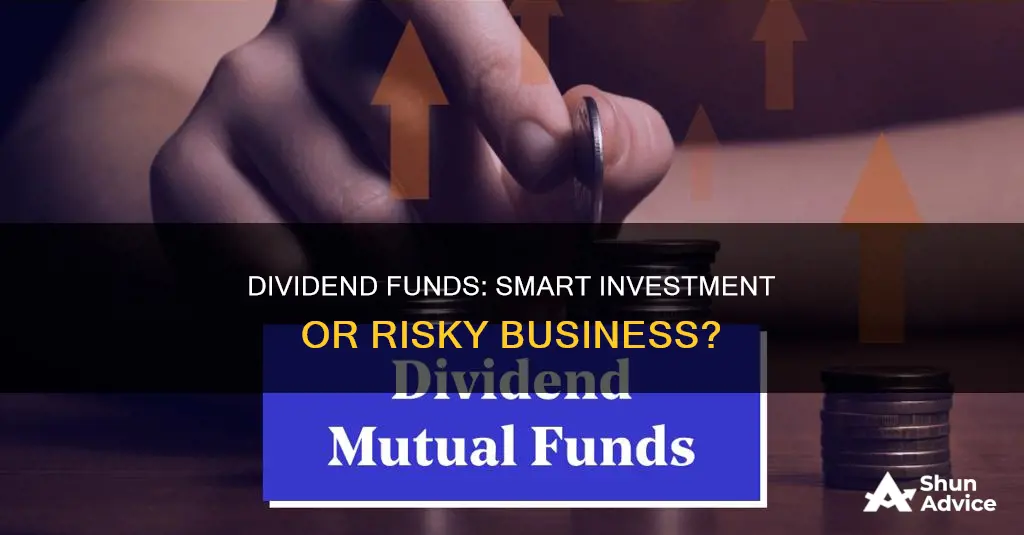
Dividend stocks can be a great choice for investors looking for passive income. Dividend stocks or dividend funds can help you earn regular passive income from some of the strongest companies in the economy. Dividend stocks provide dual benefits: income from dividends and capital appreciation, often outperforming with lower volatility.
Dividend funds hold a significant amount of dividend-paying stocks. A dividend fund collects the dividends it gets from its stock holdings, then distributes them to shareholders based on the number of shares owned. Dividend funds tend to hold up better in downturns than other equity funds.
Before investing in dividend stocks, it is important to know how to evaluate them. These metrics can help you understand how much to expect in dividends, how reliable a dividend might be, and how to identify red flags.
| Characteristics | Values |
|---|---|
| Investment type | Individual stocks, high-yield mutual funds and ETFs, dividend-appreciation funds and ETFs |
| Income | Dividend funds can provide a stable and consistent source of income |
| Yield | Dividend funds often generate higher dividend yields than broad-market indexes |
| Resilience | Dividend funds tend to hold up better in downturns than other equity funds |
| Risk | Dividend funds are less volatile than non-dividend stocks |
| Taxation | Dividends are taxed as ordinary income at the tax filer's rate based on their overall income |
| Suitability | Dividend funds are suitable for investors looking for lower-risk investments, especially those in or nearing retirement |
What You'll Learn

Dividend stocks vs. dividend funds
Dividend stocks are shares in a company that regularly pays out a portion of its profits to shareholders. Dividend funds, on the other hand, are a type of investment fund, such as an exchange-traded fund (ETF) or mutual fund, that holds a selection of dividend stocks.
Both dividend stocks and dividend funds can be good options for investors looking for regular income, but there are some key differences to consider when deciding which is right for you.
Benefits of dividend stocks
- Potential for higher returns: While investing in individual dividend stocks requires more research and work on the part of the investor, it can also offer the potential for higher returns than a dividend fund. By carefully selecting individual stocks, investors can build a custom portfolio that may offer a higher yield.
- Lower expenses: Dividend stocks may have lower expenses than dividend funds, as ETFs and mutual funds typically charge an annual fee called an expense ratio.
- Tax efficiency: Dividends on stocks held in taxable accounts are taxed at a lower rate than ordinary income. For investors in high-income brackets, this can make dividend stocks a more tax-efficient option than dividend funds.
Benefits of dividend funds
- Diversification: Dividend funds provide instant diversification by spreading your investment across a larger number of companies, reducing the risk associated with picking individual stocks.
- Lower risk: Dividend funds are typically less risky than investing in individual stocks because they provide exposure to a diversified portfolio of companies. This reduces the impact of any one stock on the overall performance of the fund.
- Ease and convenience: Dividend funds offer the benefit of convenience, as they provide access to a selection of dividend stocks in a single investment. This means you only need to make one transaction to own a portfolio of dividend stocks.
- Income consistency: Dividend funds are designed to provide consistent income by collecting dividends from multiple underlying stocks. Even if one stock in the fund cuts or suspends its dividend, you can still rely on income from the others.
- Passive investing: Dividend funds are passively managed, which means investors don't need to spend time researching and analyzing individual stocks.
The decision to invest in dividend stocks or dividend funds depends on your financial goals, risk tolerance, and investment style.
Dividend stocks may be a better option for more experienced investors who are comfortable conducting research and have the time to build and manage a custom portfolio.
Dividend funds, on the other hand, are generally a safer and more hands-off approach that is suitable for investors seeking a low-cost, diversified, and reliable source of income.
Ultimately, the choice between dividend stocks and dividend funds comes down to your personal preferences, investment goals, and tolerance for risk.
Diversification: A Key Advantage of Mutual Fund Investments
You may want to see also

High-yield mutual funds and ETFs
One example of a high-dividend ETF is the Vanguard High Dividend Yield ETF (VYM), which holds consistent dividend-paying companies such as JPMorgan Chase, Johnson & Johnson, and Home Depot. The fund also boasts low annual expenses of just 0.06%, making it a cost-effective option for investors.
For those seeking a more aggressive approach, the Global X SuperDividend ETF (SDIV) covers all sectors and geographies, with only about a third of its assets in the US. This fund is heavily weighted towards financials and energy, and while it carries more risk, it offers a very high dividend yield of 10.7%.
Another option is the Invesco High Yield Equity Dividend Achievers ETF (PEY), which is based on the Nasdaq Dividend Achievers Index. This fund focuses on US dividend stocks that have increased their annual dividend for a minimum of 10 consecutive years, ensuring a proven track record of dividend growth.
When considering high-yield mutual funds and ETFs, it is important to remember that dividend yields are not the sole factor to consider. It is crucial to assess the underlying companies, their financial health, and the stability of their dividend payouts. Additionally, investors should be aware of the tax implications of dividend income and the potential impact of rising interest rates on dividend-focused funds.
Mutual Funds: Diversify Your Investments, Secure Your Future
You may want to see also

Dividend-appreciation funds and ETFs
One of the largest dividend-focused ETFs is the Vanguard Dividend Appreciation ETF (VIG), which has over $85 billion in assets under management. VIG focuses on the largest stocks instead of the largest dividends, with a dividend yield of just under 2%. While the yield may be lower, the fund offers stability and includes very stable payouts from large companies.
For a higher dividend yield, the Schwab US Dividend Equity ETF (SCHD) is a massive and popular fund with a dividend yield of 3.4%. SCHD is more selective, including about 100 blue-chip stocks, with top holdings in defence, healthcare, and consumer goods.
The Vanguard High Dividend Yield ETF (VYM) is another popular option, with about 500 total positions that include large dividend stocks and mid-sized payers. VYM has a dividend yield of nearly twice that of the S&P 500, at 2.8%.
The ProShares S&P 500 Aristocrats (NOBL) is a more tactical ETF, focusing on Wall Street's Dividend Aristocrats. These are companies that have increased their payouts for at least 25 consecutive years, including during market meltdowns. While the overall yield is not extremely high, currently at 2%, the fund offers a strong history of raising dividends.
The Capital Group Dividend Value ETF (CGDV) is a boutique dividend ETF that seeks out value-oriented opportunities. It includes stocks that may not pay dividends yet but are likely to in the future. The fund has a dividend yield of 1.4% but has had a strong year-to-date return of 16%, outperforming the S&P 500.
For a more aggressive approach, the Global X SuperDividend ETF (SDIV) seeks big payouts, including a heavy focus on real estate stocks and international investments, with a dividend yield of 10.7%. However, this fund is more risky and volatile, and the yield should not be the only consideration.
The iShares International Select Dividend ETF (IDV) is another unique option, focusing exclusively on international companies that pay back shareholders. These distributions are typically much bigger than domestic companies, and IDV provides a simple way to access these high-dividend investments. IDV has a dividend yield of 6.2%.
Overall, dividend-appreciation funds and ETFs offer a great way to invest in dividend stocks, providing diversification, stability, and the potential for higher income.
Best Mutual Funds for Tax Savings: Where to Invest?
You may want to see also

Cash flow
Dividend funds can provide investors with a stable and consistent source of income. Dividend funds collect the dividends they receive from their stock holdings and then distribute them to shareholders based on the number of shares owned. Many companies, especially those in the energy, utilities, and financial services sectors, pay dividends.
Dividend funds can be a great way to earn additional income. However, if you own dividend securities in a taxable brokerage account, you will have to pay taxes on the income you receive, even if you reinvest those dividends. To avoid taxes, you can own the shares in a tax-advantaged account such as an IRA or 401(k).
Dividend funds' distributions provide investors with a stable and consistent source of income. These funds often generate higher dividend yields than broad-market indexes, which can appeal to income-oriented investors.
According to Morningstar analyst Todd Trubey, "Dividend funds tend, as a group, to hold up better in downturns than other equity funds." Dividend funds tend to be less volatile than non-dividend stocks. This is because investors in dividend stocks tend to be buy-and-hold investors looking for passive income rather than very active traders.
Dividend funds should hold at least 100 stocks and have no more than one-third of their assets in their ten largest holdings. Dividend funds should also keep turnover within reasonable limits, ideally around 40% or less. This prevents the fund from racking up trading costs and indicates that it is not churning through stocks to chase dividend-payers.
Low fees and broad diversification are among the most important traits to consider when selecting a dividend fund. Well-constructed dividend funds, whether active or passive, should consistently deliver the style they are attempting to achieve while controlling the risks they take.
Offshore Investment Fund Setup: A Comprehensive Guide
You may want to see also

Resilience
Dividend funds tend to be more resilient than other equity funds during downturns. This is because dividend funds hold a significant amount of dividend-paying stocks, which are typically issued by stable and profitable companies.
Dividend-paying companies are often larger, well-established firms with strong cash flow and low debt-to-equity ratios. They tend to be less volatile than non-dividend stocks, as investors in dividend stocks are usually buy-and-hold investors seeking passive income rather than active traders.
Dividend funds can also be more resilient than individual dividend stocks, as they are diversified across a range of industries. If one stock in the fund cuts or suspends its dividend, investors can still rely on income from the others.
However, it's important to note that dividend stocks and funds are still vulnerable to periods of market volatility, and there is always a risk that dividend payments could be cut or eliminated due to financial difficulties.
Fundrise: Exploring Alternative Investment Opportunities and Strategies
You may want to see also
Frequently asked questions
Dividend funds are a great way to earn additional income by investing in stocks that pay dividends. Dividend funds can be in the form of mutual funds or exchange-traded funds (ETFs) that hold a basket of stocks that pay dividends.
You can invest in dividend funds by opening a brokerage account, funding your account, and then choosing which dividend funds to invest in. Most online brokers provide commission-free stock trading, making it a straightforward and accessible process.
Investing in dividend funds offers a stable and consistent source of income through dividend distributions. These funds often generate higher dividend yields than broad market indexes, making them appealing to income-oriented investors. Additionally, dividend funds tend to hold up better during market downturns compared to other equity funds.







